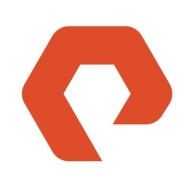


Nasuni and IBM FlashSystem compete in the enterprise storage solutions category. Nasuni seems to have the upper hand in terms of cloud capabilities, whereas IBM FlashSystem excels in performance and virtualization.
Features: Nasuni offers features such as global file locking, disaster recovery, and unlimited capacity, making it efficient for file management and restoration. It provides a unified view of file data, which enhances collaboration and auditing. IBM FlashSystem focuses on high performance with efficient IOPS, low latency, and ease of use. It includes storage virtualization, real-time compression, and unified management interfaces for scalability.
Room for Improvement: Nasuni could enhance cloud mirroring, replication speed, and support for platforms like OneDrive or Box.com. It also needs to improve user interface enhancements and training resources. IBM FlashSystem needs to improve stability and third-party integrations, along with enhancing built-in reporting, monitoring tools, and deduplication efficiency.
Ease of Deployment and Customer Service: Nasuni's hybrid deployment is flexible for public and private clouds, though it faces some support responsiveness issues during peak times. IBM FlashSystem excels in on-premises deployment and is known for above-average customer service. While both have positive support feedback, Nasuni's wider cloud focus contrasts IBM's traditional on-premises approach.
Pricing and ROI: Nasuni's pricing model includes a license per terabyte, cloud storage costs, and virtual machine fees, ideal for enterprises seeking cloud solutions with infrastructure savings. It offers significant ROI through reduced on-premise capital costs. IBM FlashSystem, though more expensive, provides cost-effective licensing with high-performance capabilities, often seen as competitively priced given its performance and functionality.
By opting for the gold subscription every three years, you get a free upgrade to the latest controller release.
If you wait more than seven years to buy another one, you get a return on your investment.
The solution can comfortably be stretched from five to seven years without any failures, ensuring a long-lasting return.
We have seen return on investment compared to other OEMs, which took approximately three years after implementing IBM FlashSystem.
We also had one outage where a controller of one of the products had failed and had to be replaced on-site.
Customers always have their issues resolved promptly.
Pure has good storage.
Customers of alternatives like Dell and Hitachi enjoy more reliable and comprehensive support services directly from vendors rather than third-party subsidiaries.
I rate the technical support from IBM as a ten.
IBM customer support is responsible, efficient, and responsive, though it is expensive.
It is highly scalable.
It is suitable for both medium-sized and enterprise businesses.
It hasn't broken down anytime in the last six to seven years, despite hurricanes, earthquakes, and power outages.
For larger enterprises, scalability is an issue as the price becomes prohibitive.
The problem arises when migrating data to a later IBM FlashSystem version due to issues with firmware compatibility.
The scalability of IBM FlashSystem is exceptional, and I rate it as a nine.
I rated the scalability as seven because even though the solution can scale, load balancing must be done manually, as it's not automated.
During the eight years, there have been no problems such as hardware failure or stopping.
I would rate the stability of the solution as a ten out of ten.
I would rate the stability of the product at seven out of ten.
Customers have infrastructure that is 100% stable.
The firmware and software engine have fewer bugs, which enhances operational efficiency.
We would appreciate a built-in transparent failover in the next release to eliminate the need for a separate metro cluster.
I'm eagerly anticipating the roadmap's promise of introducing multiple controllers, which could significantly boost scalability and resilience.
We mostly rely on long-term releases. We don't need the most up-to-date features, but we need a reliable environment.
Despite marketing promises, these features do not function effectively and can impact performance.
There is room for improvement in the troubleshooting part, specifically related to IBM Spectrum for Insight.
An additional function that could be helpful is reducing the time it takes to delete volumes, especially if they are compressed or deduplicated.
I suggest Nasuni improve their syslog forwarders to support TCP protocol, as it's more secure than UDP, which is plain text and not protected at all.
While the prices may be higher than those of other vendors, we see it as a market leader with benefits.
The support can be a bit pricey, but the solution is more cost-effective than anything else out there.
I would give it a nine out of ten in terms of costliness.
To install or upgrade any software features, the cost is high, which makes it challenging for smaller companies who do not require advanced features like deduplication or compression typically needed by larger organizations.
I prefer solutions with lower pricing.
Pure Storage has signature security technology, which cannot be deleted, even if you are an administrator.
The platform's robust features include excellent sustainability tracking, and a comprehensive dashboard offering insights into IOPS, bandwidth, performance, and virtual activities.
Its data compression feature is the best that we have ever seen.
There is a significant amount of data reduction, achieving a ratio of one to three.
There is built-in compression, a data reduction feature, and artificial intelligence-driven insights that calculate warnings and errors to redirect to customers automatically.
When integrated properly into the environment and configured according to the guidelines, it provides a very solid infrastructure that does the job on demand.
The features I find most valuable in Nasuni are the unlimited snapshots, antivirus capabilities, auditing, and ransomware protection.



Pure Storage FlashArray//X is the world’s first enterprise-class, all-NVMe flash storage array. It represents a new class of storage – shared accelerated storage, which is a term coined by Gartner – that delivers major breakthroughs in performance, simplicity, and consolidation.
IBM FlashSystem products are enterprise computer data storage systems that store data on flash memory chips. Unlike storage systems that use standard solid-state drives, IBM FlashSystem products incorporate custom hardware based on technology from the 2012 acquisition of Texas Memory Systems. This hardware provides performance, reliability, and efficiency benefits versus competitive offerings.
Nasuni is a file data services enterprise focused on assisting firms with their digital transformation, global expansion, and information awareness. The Nasuni File Data Platform is a suite of cloud-based services designed to enhance user productivity, ensure business continuity, provide data intelligence, offer cloud options, and simplify global infrastructure. This platform and its auxiliary services are projected to replace conventional file infrastructure such as network attached storage (NAS), backup, and Disaster Recovery (DR), with an expandable cloud-scale solution. By storing file data in scalable cloud object storage from multiple providers, Nasuni positions itself as a cloud-native alternative for traditional NAS and file server infrastructure. Based in Boston, Massachusetts, USA, Nasuni serves sectors like manufacturing, construction, technology, oil and gas, financial services, and public sector worldwide, offering its services in more than 70 countries.
James J., IT Manager at a marketing services firm, says Nasuni’s management dashboard is helpful because he's able to view all of the different filers at once rather than check each one of them individually. He values the software’s security, reliability, good performance, helpful alerting, and responsive support.
According to a Server Engineering Services Lead at a mining and metals company, Nasuni offers good OR and DR capabilities, performs well, offers data security, and continuous file versioning helps recover from hardware failures.
The Managing Director of IT at a construction company appreciates Nasuni because it eliminates a lot of work that was previously done when managing backing up and restoring data files.
We monitor all NAS reviews to prevent fraudulent reviews and keep review quality high. We do not post reviews by company employees or direct competitors. We validate each review for authenticity via cross-reference with LinkedIn, and personal follow-up with the reviewer when necessary.